Home Theater Speakers
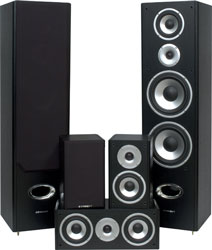 The purpose of a home theater speakers (sometimes spelt home theatre speakers) is to recreate the experience of a professional movie theater. In today's home theaters
across the globe this is achieved in any number of ways. Generally a home theater consists of a large television,
a DVD player, an amplifier or audio/video receiver and, of course, home theater speakers.
The purpose of a home theater speakers (sometimes spelt home theatre speakers) is to recreate the experience of a professional movie theater. In today's home theaters
across the globe this is achieved in any number of ways. Generally a home theater consists of a large television,
a DVD player, an amplifier or audio/video receiver and, of course, home theater speakers.
The most common home theatre speakers configuration found today in our homes would be the 5.1 setup (five main speakers plus one
low frequency speaker). The main speakers (three in the front and two to the sides or rear) are called the left
front, center, right front, surround left and surround right. The low frequency speaker is called a subwoofer or "sub" for short and can
be placed in a variety of locations in the home theater listening area but is most commonly found in a corner to the right or left
of the viewing screen.
Other expanded variations of the 5.1 configuration would be the 6.1 and 7.1 which consists of six main speakers and a subwoofer
or seven main speakers and a subwoofer, respectively. These expanded variations allow for the audience to be more thoroughly
surrounded in the soundscape increasing the realism of the experience.
Home Audio Speaker System Types
In today's home audio and home theater setups speaker types are generally referred to as 2-way, 3-way and 4-way etc. and
normally contain 2 or more drivers. What this refers to is how the audio signal that is sent to a speaker is separated
(by the crossover) and distributed to the individual drivers. In a 2-way system, for instance, the signal is separated into
two distinct sections with each section being delivered to one or more drivers within the cabinet.
The simplest example would be a standard
2-way 2-driver speaker (with one midrange/woofer driver and one tweeter driver).
The crossover would extract the sounds from an audio channel at
the lowest point the speaker can reproduce (as specified by the low value of the speakers frequency response specification) up
to the "crossover frequency" (as determined by the "programming" of the crossover) and would send that signal
(e.g., 70 Hz to 4 kHz) to the speakers larger midrange/woofer driver. All frequencies above the crossover frequency would
then be sent to the second driver, the tweeter (e.g., 4 kHz to 20 kHz).
In more complex speakers with even more drivers the signal may be split further into even smaller pieces and distributed among the
speakers, each being responsible for reproducing a portion of the sound channel as a whole. Larger drivers are responsible for
reproducing low frequency sounds and the smaller drivers and tweeters are responsible for reproducing higher frequency sounds.
Front Channel Speakers

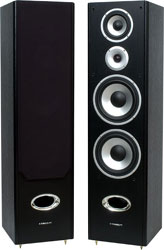
The left front and right front speakers are called upon to reproduce the main sounds in a soundtrack. Generally
these speakers are full range speakers reproducing a broad frequency range from 20 kHz (20,000 Hz) down to 50 Hz and lower
(the human threshold for sound in about 20 Hz on the low end and 20,000 Hz on the high end).
Center Channel Speaker
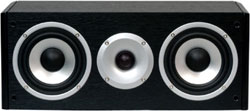
The center channel speaker in a home theater is largely responsible for the vocals in a soundtrack and is placed above or
below the viewing screen to anchor those voices to the visuals. Center channel frequency responses typically start at 60 Hz up to
100 Hz on the low end and extend up to 20 kHz on the high end.
Rear Channel Surround Sound Speakers
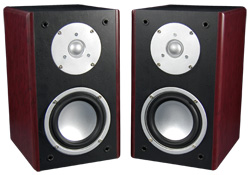 The rear channel speakers, or surround sound speakers, allow us to fully immerse
ourselves within the soundscape. By surrounding the listening area with speakers a 3D environment is created that mimcs how we
would experience sound in real life --- coming from all around us. Streem rear surround speakers are available in a
monopole and bipole design.
The rear channel speakers, or surround sound speakers, allow us to fully immerse
ourselves within the soundscape. By surrounding the listening area with speakers a 3D environment is created that mimcs how we
would experience sound in real life --- coming from all around us. Streem rear surround speakers are available in a
monopole and bipole design.
Low Frequency Subwoofer
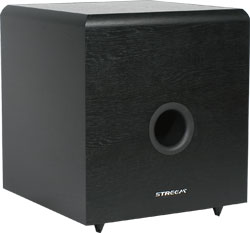
The "point one" in today's 5.1, 6.1 and 7.1 home theater speaker systems refers to the subwoofer channel. Low frequency sounds
are encoded into a channel of a soundtrack for output using a subwoofer. A subwoofer usually contains one, but sometimes multiple,
large drivers that are needed to reproduce these low frequencies. The frequency response of a subwoofer is typically narrow
ranging from 30 (and sometimes lower depending on the size of the subwoofer cabinet) to 100 or 150 Hz. As low frequency sounds
are omni-directional and difficult to pinpoint the placement of a subwoofer in a home theatre is very flexible.
Resources for Home Theatre Speakers:





